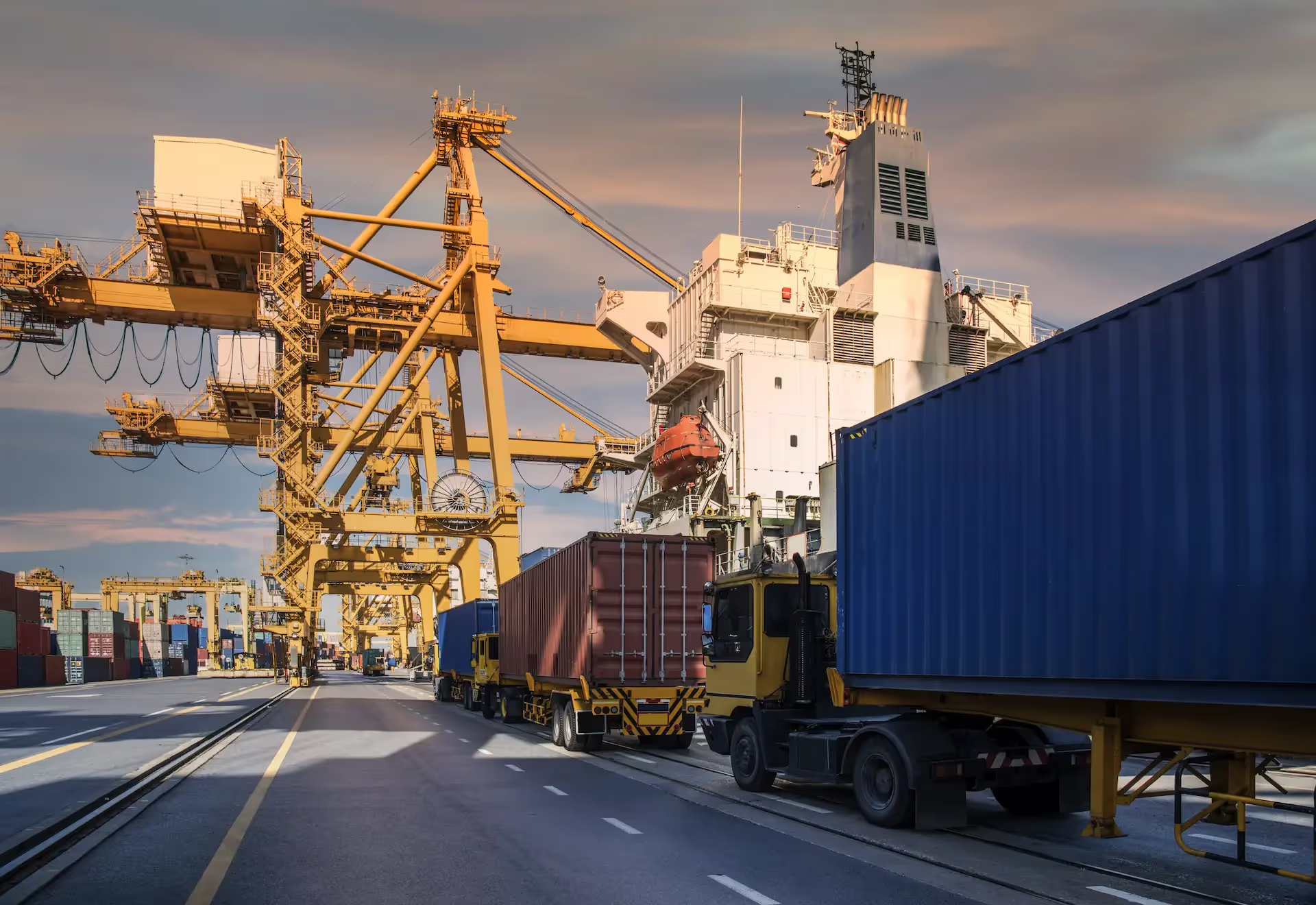Key Points
- Real-time visibility provides instant supply chain insights for improved transparency
- It enables proactive decision-making by tracking shipments and inventory levels continuously
- Improved visibility leads to increased efficiency and reduced operational costs
- Real-time data supports better customer service and supply chain resilience.
What is supply chain logistics?
.webp)
Supply chain logistics is regarded as the backbone of global trade, comprising a network of transportation, warehousing, and inventory. As the areas of purchasing, materials handling, logistics, transportation, inventory control, and supply chain management continue to evolve, a lot of these functions intersect with each other, blurring some of the distinctions between them.The terms ‘supply chain’ and ‘logistics’ are sometimes used interchangeably but there are in fact some important differences.
‘Supply chain’ is broader, involving sourcing, processing and delivery of goods to customers, whereas ‘logistics’ is focused more specifically on moving and storing goods throughout supply chains, and other types of sub processes within supply chains. Those in charge of supply chain logistics, such as a VP of Supply Chain for example, must understand:
- how to leverage the most advantageous transport mode,
- how to design and set up a warehousing facility,
- how to manage and control inventory and assets, and
- how to create an efficient logistics network that delivers both low costs and high levels of customer satisfaction.
Confusingly, the meaning of terms varies from place to place. The term ‘supply chain management’, as understood and used in the US, is sometimes referred to as ‘logistics management’ in Europe.
What is supply chain management?
Supply chain management refers to collaboration between firms that connects suppliers, customers and other ecosystem partners to boost efficiency and add value for end customers. A typical supply chain consists of manufacturers, wholesalers, distributors and retailers. Supply chain management can be understood as a set of strategic decisions, which sets up “the operational framework within which logistics is performed.”
What is logistics?
Logistics is just one part of supply chain management. Logistics is considered “part of the end-to-end supply chain process that plans, implements and controls the efficient, effective forward and reverse flow and storage of goods, services and related information between the point of origin and the point of consumption in order to meet customer’s requirements”.
Logistics plans how to move goods from one place to another, store those goods and produce the necessary documentation for reporting and processing, using multiple types of transport. It involves activities that move and position inventory and acknowledge its role in terms of synchronizing the supply chain. It’s about ensuring products desired are received by customers at the right place, at the right time.
Logistics is split into two categories; inbound and outbound. Inbound concerns upstream activities relating to obtaining, handling, storing and transporting materials. Outbound involves downstream activities such as collection, maintenance and distribution of products to customers.
Good logistics is all about efficient transport and storage and is essential to good supply chain performance. However each logistics operation is only responsible for a unique and self-contained part within the supply chain. These supply chain ‘subsections’ are sometimes managed by different providers
Logistics providers also control how goods move with fleet management, shipment tracking and information sharing with partner organizations throughout the supply chain. They use a variety of land, air and sea transportation methods to move goods swiftly and efficiently, taking advantage of containerization to enable intermodal transport. Goods are then stored until needed by distributors, retailers or delivery to end customers (last mile delivery).
What are the key differences between supply chain management and logistics?
.webp)
Although the terms shouldn’t be used interchangeably, each concept is unable to exist without the other. There are many important differences between the functions, capabilities, inputs, and outputs of each. At a high level, supply chains are responsible for the overall sourcing, processing, and delivery of goods to the end customer, whereas logistics focuses more on moving and storing goods between different organizations within a supply chain.
Supply chain management is about leveraging logistics and supply chain-related processes into competitive advantage, whereas the main focus of logistics is more customer-focused, ensuring customer requirements are met.
Challenges of supply chain logistics
Supply chain logistics challenges often center around the areas of customer service, cost control, planning and risk management, supplier/partner relationship management, and talent acquisition.
Often, a major objective of supply chain logistics is to enable an organization to be agile and flexible enough to grow and expand the company globally into new markets in order to remain competitive. There is therefore a considerable amount of relationship management required with customers and suppliers.
Increasingly, technology is being leveraged to improve personalization and process efficiency. Things like advanced supply chain management systems, customer relationship management systems, and Big Data are popular tools to do this. At the same time, they’re helping to meet new customer demands for greater order and delivery visibility, while making supply chain logistics more efficient, economical and customer-centric.
Overcoming visibility challenges of supply chain logistics
.webp)
When systems are able to integrate siloed functions across the supply chain and facilitate the sharing of real-time visibility data, it’s possible to create optimizations throughout the entire ecosystem. These include:
- Root cause analysis to identify issues in current processes so more effective solutions can be designed and implemented
- Lean approach to inventory management to help reduce waste, thanks to quicker order fulfillment and improved inventory accuracy
- Improved measurement of supply chain efficacy through benchmarking
- More accurate predictions of customer demand with demand planning tools
- Better human resource planning in response to sudden changes required within the supply chain
The benefits of visibility for supply chain logistics
A more integrated, collaborative supply chain enabled by end-to-end operational visibility improves the ability of an organization to serve its customers and helps achieve several key benefits, including:
- More seamless operations from one section of the supply chain to the next thanks to elimination of visibility blindspots
- Improved supplier relationships
- Prevention of order and process errors
- Better customer service levels, satisfaction and retention with an enhanced customer experience
- Increased cost efficiency and reduced waste, leading to lower labour and material costs
- Lower inventory costs thanks to better management of inventory with reduced buffers
- Improved agility to respond to changing market conditions and mitigated risks
- Less delays thanks to better prediction and detection of issues across the supply chain
- Shipment status updates in real-time along with accurately predicted ETAs
- Fewer disruptions with better risk mitigation
- Better view of business functions with reporting, analysis and insights all enabling improved planning and execution
Implementing real-time transportation visibility for supply chain logistics

Shippeo's powerful Supply Chain visibility platform gives you instant access to predictive and real-time information for all your deliveries. Shippeo's machine-learning, proprietary ETA algorithm allows you to quickly and accurately anticipate problems, helping you efficiently manage exceptions to mitigate their impact.
Shippeo gives you clear insights into your transportation operations, helping you make better, data-driven decisions. We aggregate precise delivery information so you can reliably measure delivery performance, do unequivocal root-cause analysis, and uncover areas of improvement.
Our dedicated in-house teams will help you and your carriers smoothly onboard onto Shippeo, ensuring your project's success. We've built a complete organization inside of Shippeo, with dedicated in-house teams entirely focused on making your implementation go as smoothly and quickly as possible.
If you want to find out more about the role of real-time transportation visibility in helping your organization achieve full end-to-end visibility to optimize your supply chain logistics, get in touch with one of our experts.
Latest blogs & product releases.
Authors







